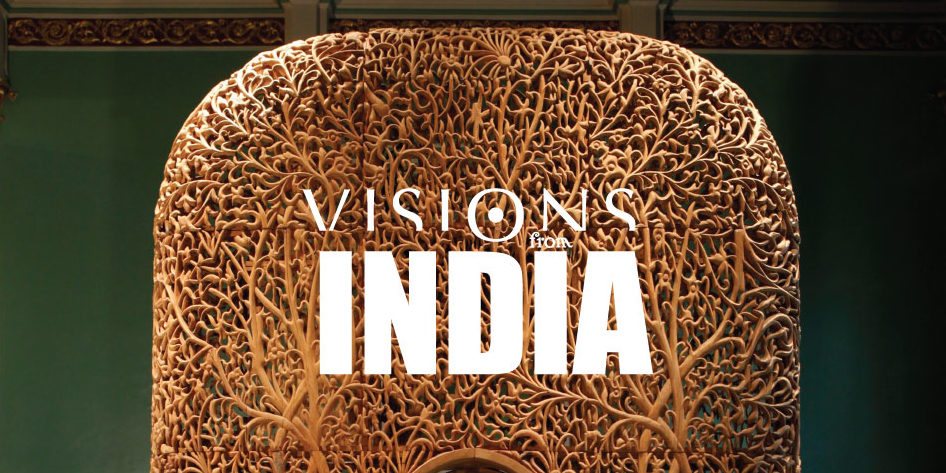Pizzuti Collection Challenges Artistic Boundaries with Visions From India

Pizzuti Collection Challenges Artistic Boundaries with Visions From India
by Matt Monta
[su_dropcap style=”flat” size=”5″]D[/su_dropcap]iscussions of art in the Western world often revolve around cities like New York, Paris, Rome, or London with praise for the great European Masters. Such discussions often fail to recognize or willingly omit contributions from other hemispheres. Consequently, India, for all of its rich cultural, religious, and artistic tradition remains shrouded in mystery to many Americans, save for some cursory textbook history. However, with Visions from India opening on Friday, March 10, Ron Pizzuti and the staff at the Pizzuti Collection intend to shine a bright light on the vibrant contemporary art emerging from India.
The exhibit showcases two collections: Transforming Vision, a collection of 21st century works from various artists; and The Progressive Master, a collection of work by Francis Newton Souza from the Rajadhyaksha Collection. Through three floors, visitors will have the chance to experience innovative and inspiring paintings, installations, and mixed-media works that provide not only visceral social and political commentary facing a globalized world but also evocative experiments that challenge concepts of space, motion, and texture.
The Transforming Vision collection is vast and diverse, featuring 44 works from 26 artists, with equal representation of men and women. The artists in the exhibit are the top of their field, Pizzuti himself notes: “If you look up the Top 25 Artists in India, all of them are here.”
[su_pullquote align=”right”]In one large room resides Subodh Gupta’s Untitled (Sushi Conveyor Belt), an imposing installation that is, quite literally, a 23 foot long motorized sushi conveyor belt used in restaurants. Atop the steel belt are copper and tin food containers stacked into precariously tall towers.[/su_pullquote]Transforming Vision showcases impressive installations by Sudarshan Shetty, including For all that we lose (2011), a 12-foot tall hollow structure composed of reclaimed teak wood, carved into elaborate design. Two small archways create a short passage from one side to the other, while a mechanized sword swings between them, perhaps suggesting that traversing through beauty is not without its mortal dangers. Also featured is Shetty’s work Untitled (2008), with life sized cast aluminum dog skeletons encased in blocky red acrylic. Inside each case is a hidden surveillance camera, whose field of vision is displayed on a set of screens behind the pack. At a time when our daily habits can be tracked to the minute by cell phones, watches, and websites, this piece reminds contemporary viewers how something seemingly innocuous could easily serve as an invasive instrument.
In one large room resides Subodh Gupta’s Untitled (Sushi Conveyor Belt), an imposing installation that is, quite literally, a 23 foot long motorized sushi conveyor belt used in restaurants. Atop the steel belt are copper and tin food containers stacked into precariously tall towers. When the belt is activated, the towers move slowly in a mesmerizing undulation that can at once be dizzying and soothingly hypnotic, allowing the viewer freedom of mind to speculate its meaning.
[su_pullquote align=”right”]Other works bring forward commentary on the devastating consequences of war that has ravaged south Asia and the Middle East. Reena Saini Kallat’s Xylophone II, a 14-piece drawing reaching 9 and a half feet tall, creates an image of a rib cage, yet instead of human bone, automatic weapons and rifles encase the vital lungs and heart.[/su_pullquote]In addition to the installations, powerful paintings are on display such as Jagannath Panda’s work, Untitled, which portrays a statue of Mahatma Gandhi, the legendary leader of the Indian independence movement, covered in pigeons and their excrement while modern towers line the horizon. The sad image is suggestive of an amnesiac generation that is neglectful or ignorant of the important figures and movements in its history.
Other works bring forward commentary on the devastating consequences of war that has ravaged south Asia and the Middle East. Reena Saini Kallat’s Xylophone II, a 14-piece drawing reaching 9 and a half feet tall, creates an image of a rib cage, yet instead of human bone, automatic weapons and rifles encase the vital lungs and heart. Double Duty, an oil painting by Kanishka Raja, presents a modern cosmopolitan airport lined with cots typically associated with refugees, demonstrating the transience and stark disparity between those who travel for pleasure and those who travel for survival.
Transforming Vision also contains a number of abstract pieces such as Deja Vu, So Much for Now, and What! by Sheila Makhijani as well as Landscape of Waking Memories, a work by Sakshi Gupta composed of chicken feathers, galvanized wire, and mesh.
The other celebrated artist in the Visions from India exhibit is Francis Newton Souza, one of the most prominent Indian artists who is showcased in his own gallery, The Progressive Master. In a quiet room, visitors have the opportunity to embrace the pieces that are truly reflective of Souza’s cosmopolitan background.
Visions from India opens at the Pizzuti Collection this Friday, March 10 and will continue through October 28. Over the course of the exhibit, the Pizzuti Collection will host a series of programs including artist talks with Sudarshan Shetty and others, poetry nights, and family programming. Whether one is or is not familiar with Indian art, culture, or history, Visions from India creates a personal and memorable experience that breaks down the arbitrary boundaries of the traditional art world.
Learn more at www.pizzuticollection.com
BROUGHT TO YOU BY



